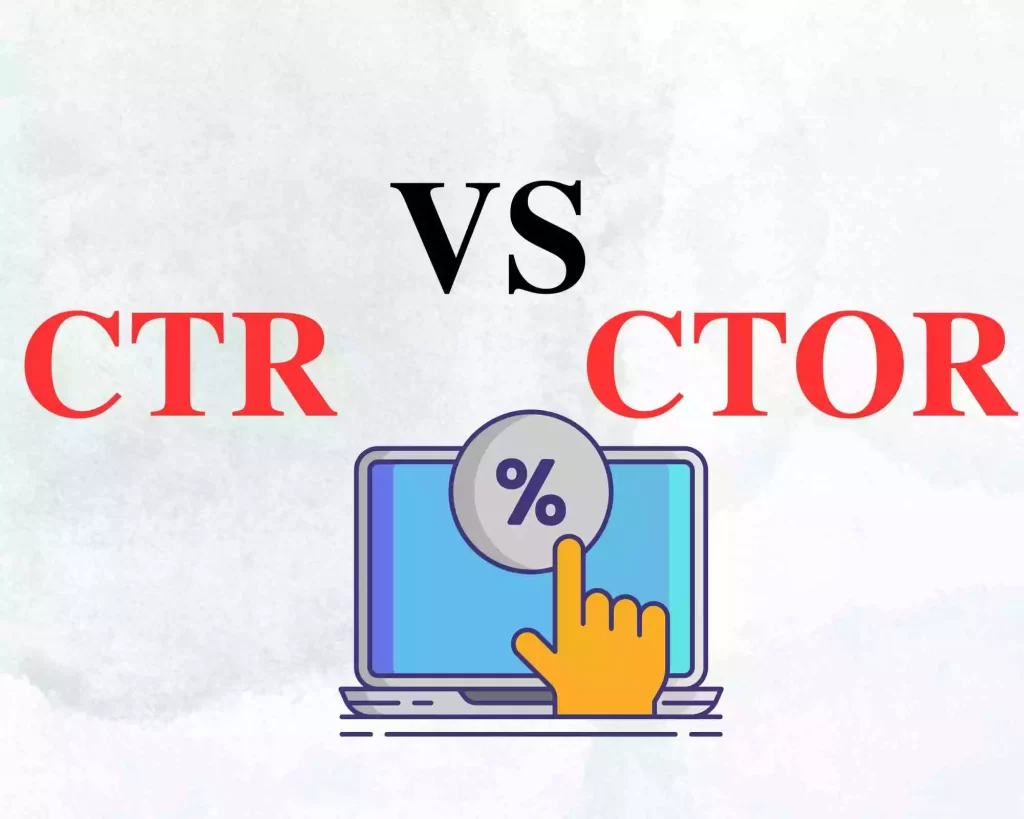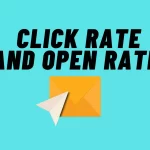Are you usually getting confused about what email Click Through Rate Vs Email To Open Rate Implies?
Both emails’ click through rates and click to open Rate are fairly similar, but the little difference in it is that email Click Through Rate measures the clicks as a percentage of all the emails sent, while the email Click-To-Open Rate measures clicks as a percentage of opens.
Do you understand that?
If No!!!, read on for a deeper understanding!
As an email marketer, I also do a mistake with the term Click Through Rate to Click To Open Rate. Yet to my surprise, the two are simply pretty distinct from one other.
In this blog post am going to go further in a simple and understandable approach to the difference between email click-through Rates and click-to-open Rates.
Read our Guide on the difference between click rate and open Rate.
Let’s get started.
What Is Click Through Rate In Email
Marketing?
The email click-through rate (also known as the email click rate) is the number of clicks your email receives out of all the emails sent.
How To Calculate Email Click Through Rate
(Total Number of Clicks/Total Number of Delivered Emails) X 100 = Email Click-Through Rate.
For example, Let’s add you send an email to 2000 subscribers and discover that 20 of them clicked on a link in the email. Your CTR is 1%.
I hope you’ve had a better understanding of what email Click Through Rate is. If not, endeavor to try reading the sentence again.
Now let’s check what email Click To Open Rate is.
What Is Click Open Rate In Email Marketing?
Unlike email
Click Through Rate. The Click-To-Open Rate (CTOR) is the number of clicks your email receives out of
all the number of emails opened.
How To Calculate Email Click To Open Rate
(Total Number of Clicks/Total Number of Opened Emails) X 100 = Email Click To Open Rate.
Now, an example. Suppose you send an email to 2000 people, and 100 of them open it. Of those 100, 50 click on a link in the email. That means that your ctor for that email is 50%.
Is Click To Open Rate the Same As Click-Through Rate?
With all the explanations I did earlier, I am sure you should know
the answer to the question. The answer to the question is NO.
Both the click-to-open Rate and click-through Rate are totally different. Let’s go deeper into what the difference is.
What Is The Difference Between Email CTR
And CTOR?
The click-through rate (CTR) simply counts the number of emails in which a receiver clicks on the link in it.
Thus, like my explanation earlier, let’s assume you send out 2,000 emails and subsequently discover that 20 individuals clicked on the link in your message. Your CTR is 1%.
While the click-to-open Rate (CTOR) measures the proportion of recipients who opened the email and followed the link.
In these metrics, we don’t measure the number of individuals who got the email in their inboxes. Instead, we’d want to know how many users opened it and then clicked the CTA.
Maybe 100 of the 2,000 recipients clicked to open the mail. Then, 20 people clicked the link, giving you a CTOR of 5%.
CTOR is undoubtedly the finest indicator for assessing the overall efficacy of your email campaign’s message. If you have a high CTOR, it suggests you’re connecting with the right audience.
Additionally, the click-to-open Rate should not be confused with the open Rate, which is just the proportion of receivers that opened the email out of the total number of recipients.
If 100 of 2,000 recipients clicked on the email in their inbox, the open rate would be 20%.
The main difference between the click-through rate and the click-to-open Rate is small, but there’s a reason effective email marketers worry about both. An email may have a low click-through rate yet an incredibly amazing click-to-open rate. Measuring and comprehending both is critical for building an email list that constantly adds to your company’s bottom line.
In general, a lower CTR but a higher CTOR might indicate that your emails are well designed, but you are sending them to subscribers who do not desire that kind of communication.
A low click-to-open rate, on the other hand, shows that your emails aren’t well-crafted to engage your readers. As a result, when consumers read your emails, they don’t do much clicking.
Which Is Better, CTR Or CTOR?
This is a very tricky question, which I don’t have a perfect answer. I’m not claiming that the
CTOR is better than CTR, or that one provides a more accurate image than the
other.
The fact is that they show two completely different things. Unlike the CTR, which measures an email’s overall performance (which is a result of many various variables), the CTOR just looks at the success of the content inside the email.
Both metrics are very important tools to have in your email marketing. You’ll be able to send emails effectively if you focus on these metrics.!
Factors That Affect Click-To-Open Rate
And Click Through Rate
Click Through Rate and Click To Open Rate might be affected by one or more factors. These are only a few of the usual issues that affect them the most!
1. Subject Headings
If the subject line reads “100% guaranteed,” “great deal,” or “best pricing,” the ESP will deem the email spam. It will then activate the spam filter, which will direct the email to the spam folder.
It is also not recommended to utilize BLOCK letters in the subject line. That causes Spam, and Email Service Providers (ESPs) will blacklist you if you continue to do so.
And if your email ends up in Spam. It will surely affect the Click Through and Click To Open Rates. Read our Guide on how to prevent that from happening.
2. CTA
The CTR and CTOR will surely be affected if the email copy does not provide what the consumer should do. If the receiver cannot see the call to action, he will not click on any of your websites or landing pages. 1 CTA is good in an email (in the middle or at the conclusion of the email text). However, some email marketers may place two CTAs – one in the banner and one at the end of the email copy.
3. The Frequency With Which Emails Are Sent
Spamming your consumers with emails will not raise their open Rate. It will irritate them to the point that they will unsubscribe or report you as a spammer. Sending seldom is also not ideal since you may quickly slip their memory.
4. Not Mobile Friendly.
If your emails are not mobile-friendly, a large percentage of your users will not even open them and will quickly trash them. In fact, mobile remains the most preferred reading environment, with smartphones and tablets accounting for 46% of all emails open.
5.. Spam Email.
People are unlikely to read your email if it is sent to the spam folder rather than the inbox. Your emails may be labeled as Spam for a variety of reasons. The most prevalent ones are listed below.
6. Irrelevant Content
The content of your email will influence future CTR and CTOR. If you continue to provide little value in your emails, your subscribers will stop opening them. Users will not want to miss out if they are happy with your material and believe you provide value.
Read our Guide on how to write an email that stands out.
Ways To Improve Your Click-To-Open Rate And Click-Through Rate
1. Using your Click-To-Open
Rate and Click Through Rate might assist you in creating better
customer-centric content. It also provides you with an additional parameter for
measuring the performance of your email marketing initiatives.
Here are a few simple methods for increasing your click-to-open Rate and engaging your clients in your email marketing.
2. Create A Captivating Subject Headline
With so much information at our disposal, creating the ideal subject line has practically become a science these days. Before your email is even opened, the subject line, pre-header, and sender’s reputation are all seen. Consider starting with these most crucial terms.
3. Add A Call To Action
A clear call to action is an excellent approach to direct your reader to a certain objective. Consider what you’re asking of your email openers when deciding where to add your CTA.
Would you want them to:
- Purchase something.
- Contact your local shop.
- Look through your material.
Make your CTA clear, simple, and convincing, regardless of your purpose.
4. Optimize For Mobile
Individuals may work on any day, at any time, and on any device, so make your site mobile-friendly. This involves making sure the subject line is brief, to the point, and provides value to those who click to open. It also entails sending emails at times and on days when your prospects are most likely to open them—for example, avoid sending B2B emails on weekends.
5. Personalization
Even I will open any email immediately if it seems personalized, relevant, and timely. It’s critical to recognize that we compete with everything else in our consumers’ inboxes. Hence, the trick is to be extremely targeted with a message in order for it to resonate.
6. Relevant Content
After you’ve spent time analyzing and classifying your audience, you can develop more valuable content. Sending relevant content saves the reader time since they don’t have to look for useful recommendations that are relevant to them. When the email is important in and of itself, you’ve built the expectation that going through it will deliver even more information, making a choice more appealing.
Conclusion
Now that you’ve learned the difference between email Click Through Rate
And Click To Open Rate. It’s important you note that.
Click through Rate and click to open Rate are all about the clicks in your email. While the click-through Rate is the percentage of clicks you get per email sent, click to open Rate is the percentage of clicks per email opened.
It’s also important you note that email click-through Rate and Click to open Rate are crucial metrics you should track in your email campaign, and following our tips on how to improve it will go a long way In helping you out.
Read our Guide to find out what is high and low email Click Through Rates.
Wish You A Nice Emailing





